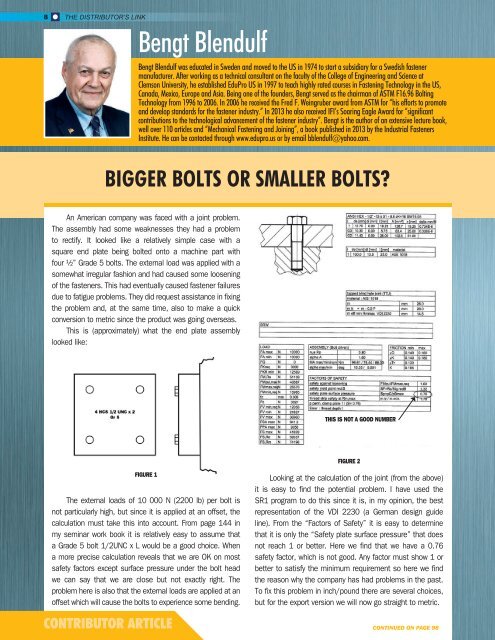SUMMER 2016
Distributor's Link Magazine Summer Issue 2016 / Vol 39 No3
Distributor's Link Magazine Summer Issue 2016 / Vol 39 No3
You also want an ePaper? Increase the reach of your titles
YUMPU automatically turns print PDFs into web optimized ePapers that Google loves.
8<br />
THE DISTRIBUTOR’S LINK<br />
Bengt Blendulf<br />
Bengt Blendulf was educated in Sweden and moved to the US in 1974 to start a subsidiary for a Swedish fastener<br />
manufacturer. After working as a technical consultant on the faculty of the College of Engineering and Science at<br />
Clemson University, he established EduPro US in 1997 to teach highly rated courses in Fastening Technology in the US,<br />
Canada, Mexico, Europe and Asia. Being one of the founders, Bengt served as the chairman of ASTM F16.96 Bolting<br />
Technology from 1996 to 2006. In 2006 he received the Fred F. Weingruber award from ASTM for “his efforts to promote<br />
and develop standards for the fastener industry.” In 2013 he also received IFI’s Soaring Eagle Award for “significant<br />
contributions to the technological advancement of the fastener industry”. Bengt is the author of an extensive lecture book,<br />
well over 110 articles and “Mechanical Fastening and Joining”, a book published in 2013 by the Industrial Fasteners<br />
Institute. He can be contacted through www.edupro.us or by email bblendulf@yahoo.com.<br />
BIGGER BOLTS OR SMALLER BOLTS?<br />
An American company was faced with a joint problem.<br />
The assembly had some weaknesses they had a problem<br />
to rectify. It looked like a relatively simple case with a<br />
square end plate being bolted onto a machine part with<br />
four ½” Grade 5 bolts. The external load was applied with a<br />
somewhat irregular fashion and had caused some loosening<br />
of the fasteners. This had eventually caused fastener failures<br />
due to fatigue problems. They did request assistance in fixing<br />
the problem and, at the same time, also to make a quick<br />
conversion to metric since the product was going overseas.<br />
This is (approximately) what the end plate assembly<br />
looked like:<br />
THIS IS NOT A GOOD NUMBER<br />
FIGURE 2<br />
FIGURE 1<br />
The external loads of 10 000 N (2200 lb) per bolt is<br />
not particularly high, but since it is applied at an offset, the<br />
calculation must take this into account. From page 144 in<br />
my seminar work book it is relatively easy to assume that<br />
a Grade 5 bolt 1/2UNC x L would be a good choice. When<br />
a more precise calculation reveals that we are OK on most<br />
safety factors except surface pressure under the bolt head<br />
we can say that we are close but not exactly right. The<br />
problem here is also that the external loads are applied at an<br />
offset which will cause the bolts to experience some bending.<br />
CONTRIBUTOR ARTICLE<br />
Looking at the calculation of the joint (from the above)<br />
it is easy to find the potential problem. I have used the<br />
SR1 program to do this since it is, in my opinion, the best<br />
representation of the VDI 2230 (a German design guide<br />
line). From the “Factors of Safety” it is easy to determine<br />
that it is only the “Safety plate surface pressure” that does<br />
not reach 1 or better. Here we find that we have a 0.76<br />
safety factor, which is not good. Any factor must show 1 or<br />
better to satisfy the minimum requirement so here we find<br />
the reason why the company has had problems in the past.<br />
To fix this problem in inch/pound there are several choices,<br />
but for the export version we will now go straight to metric.<br />
CONTINUED ON PAGE 98

















